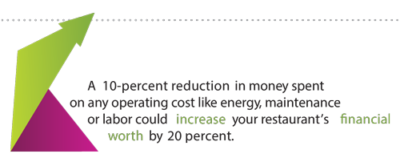
We all know that implementing an energy management plan will reduce energy costs. Besides the impact of more cash on hand, opportunities for sustainability marketing and operational fluidity, how else can your restaurant benefit by investing in energy reduction? Did you know you could actually increase the value of your business in one year by simply installing an energy management system?
As a facility manager, any steps you take to reduce building operational costs look good. Unless you’ve spent some time in the finance world, you may not be aware of just how much. A 10-percent reduction in money spent on any operating cost such as energy, maintenance or labor could increase your restaurant’s financial worth by 20 percent.
Sound too good to be true?
What is EBITDA and Why Should I Care?
EBITDA stands for “Earnings Before Interest, Taxes, Depreciation and Amortization”. EBITDA directly impacts the value of the restaurant. Banks, investors and stakeholders look at EBITDA when deciding whether or not they want to give the restaurant money. The higher your EBITDA, the more opportunities available for you to improve and grow your restaurant business.
As you know, many of the investments designed to save money have a lot of up-front costs. Your finance team uses EBITDA all the time to help procure that money for you to install what you want. If you know about EBITDA, you can more effectively convince your C-Suite to purchase or continue to purchase tools that save you as FM the most time, energy and money. You’ll be speaking their language.

The FM and EBITDA
As FM, you play two main instruments in the EBITDA game.
- Reducing Operational Costs
Any measure that you take as an FM to reduce operating costs impacts EBITDA, like energy use, maintenance truck rolls, or staff overtime hours.
- Increasing Earnings
The better your facility looks and feels to the customer, the more they tend to visit and spend money at your restaurant.
Just as a teacher uses positive reinforcement to encourage better behavior in class, the financial sector uses “multiples” to reward those who are better at the EBITDA game. EBITDA multiples determine how much value a dollar saved or earned is really worth. For the restaurant industry, the current average multiple is around ten (see Duff & Phelps, a global valuation and corporate finance advisor, “Retail Industry Insights”, 2015). That means that every $1,000 you save on operating costs is like putting $10,000 into the value of the restaurant. If you show you are superior than the rest of the pack, your restaurant gets a higher multiple, thus more value.

Easy EBITDA with Energy Management
Installing a reliable energy management system is one of the easiest things you can do to save operating costs and, as we just learned with EBITDA, increase your restaurant’s value.
If you talk to any EMS vendor, you will hear terms like “energy savings”, “operational efficiency”, “maintenance troubleshooting”, and “load management”. All of these terms relate to reducing operating costs.
For example, your restaurant could reduce operating costs associated with HVAC maintenance and labor by taking advantage of features like proactive alerts, and troubleshooting assistance for HVAC technicians.
An energy management system can also be a tool to drive earnings. There are additional real benefits of improving a customer’s experience with comfort. An energy management system can regulate temperature, and relieve you from time spent trying to achieve regular temperature. This allows less time in the realm of facility management and more time focusing on providing great customer service, preparing of food in a “wanting to return” experience, and hiring and keeping the best staff.
“I’ve been a big believer in EMS dating back to my time in the QSR industry. Having been given the opportunity to test a few systems while at Darden, this led to the implementation of 100+ EMS in our casual dining restaurant chain (Red Lobster). Our goal is to add even more next year as we weave this into our Operating Plan. I would urge you to look into energy savings applications to determine if they are right for your business then measure the results and determine if it make sense. It certainly did for us. We shaved millions of kwh from our energy bills as well as significant mcf in natural gas.
Our program includes the “push” of data to our FM’s which helps diagnose problem equipment or situations that prompt further investigation prior to failure. Recently we added full visibility to each HVAC and Water Heater for our team.”
Jack McNertney, CRFP
VP Facilities/Real Estate at Red Lobster
So how do these terms translate to real-world EBITDA corporate valuation? Here’s an example from one of your colleagues in the industry:
A restaurant chain installed energy management systems in 105 of its locations, and saved on average 7% off its energy bills. In addition to their cash savings, the chain increased its value by close to $8 million.
Now that you know about EBITDA, you know that this savings is not just being applied to return on investment (“ROI”), but to a much bigger purpose. The ability to produce accurate data about such efficiencies is more valuable than it has ever been before.

More than Energy Management
Over the past 20 years, we have seen the energy management system industry adjust its selling terminology from “save money on energy” to “data driven efficiency”. With the age of the Internet of Things (“IoT”) came the craze for data analytics, and for good reason.
IoT has made Data our purchasing assistant. The “data driven efficiency” approach is the ability to make smarter purchasing decisions and prove the efficiency of those decisions by using the data collected and calculate monetary savings more accurately.
In the 1990s, a state-of-the-art energy management system was a computer that controlled Roof Top Units (RTUs) and relied heavily on utility bills to calculate money saved from reduced energy. A modern-day EMS is a fully functional data collector, and even has the ability to tap into 3rd party data sources to reflect the bigger picture. With all this data, it is much easier to calculate how much money you save and why.
Energy management systems are a component of IoT. IoT allows for direct comparisons of datasets that are now segmented into various products and systems. In the future, your building will run like a well-oiled ship with all the electronics and mechanics working together in synchronicity that save money, and allow operations to focus purely on your customers.
The more accurately you can measure and control the factors that contribute to EBITDA, the better off your restaurant will be. If you are in the market for a new energy management system, ask your vendor if your new system can reliably function on its own, and produce data if the internet fails at the location. You may also inquire about plans to connect with other devices or systems you may have in your restaurant. As technology improves rapidly in the next few years, it is important that your new EMS automatically receive system updates. Make sure you ask the right questions to determine if this investment is future ready.
The value of your restaurant depends on it.